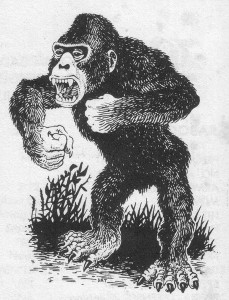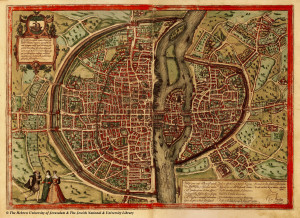[This is the fourth post in a series of session summaries (i.e., a play reports) for the first campaign I have run in the Curabel setting. Each summary was written by one of the players, but I am adding my own ‘DM Annotations’ on these write-ups before uploading them here. These annotations will mostly call attention to bits of the summaries that will be significant later in the campaign (with links to relevant summaries to follow as they are posted) or else explain my rational for my game-mastering choices.
Please note that the summary will be displayed as regular text and my annotations as block quotes throughout.]
Session Four
This game summary was written by Riese, who played the paladin Galron at this point in the campaign. Ninety-four sessions on, he’s still involved with the campaign, having just moved on to his third character (his second having fused itself with a giant mechanical worm that makes it difficult for him to continue traveling with the party).
The party was a bit smaller today at least in terms of minds.
Although I cannot recall the exact circumstances, I believe he is referring to one of the players missing the session and the impacted character being present but largely inactive.
We started off by going further into Kermit the Killer Frog’s lair, our light source dimly lighting a large open space (Kilmar the young hireling holds the lantern). The party notices they are on a balcony that has a river of sewage falling from it to a pool below and more croaking can be heard coming from the darkness.
Having the main entrance to the bullywug lair be on a balcony overlooking a large room with a central pool, two staircases to the lower level, and multiple exits was a conscious decision. As with the layout of Talessin’s tower in the earlier session, the idea was to provide interesting tactical choices to the group that wouldn’t be possible in the average 10’ wide corridor.
Soon, a weird shadow is spotted against one of the balcony’s walls – and reveals itself to be another vicious frog-creature. Galron charges and attacks it. He is joined swiftly by Thorfus who lands a hit. Galron, however, consistently fails to injure the creature. Axel also valiantly attacks with his axe. The battle creates a commotion, and soon more frogs are coming towards the party. Ir’alle, guarding the party’s flank, puts down one of the new frogs but it is clear we will be outnumbered soon …
The grim and desperate nature of low-level combat in early (A)D&D is illustrated nicely here. The Bullywugs, with their enhanced hiding ability and leap attacks, are the perfect enemy to exploit the layout of this chamber. Of course, part of the reason I like this kind of desperate combat is the sudden turnarounds in fortune that become possible when players are smart and lucky …
… HOWEVER GALRON’S FIRST KILL HAPPENS MOMENTS LATER! Thorfus murders a frog man, as well, followed soon after by Axel. Finally, Ir’alle scares off the remaining two by loudly proclaiming his faith! Unfortunately, Sthorm suffered a permanent injury … sorry about that …
Characters reduced to -6 or lower hit points are required to roll on a “permanent” injury table. The results indicate what part of the body is injured and are tied to ability score decreases and/or loss of limb use. I believe in having consequences when bad things happen and this house rule allows for that However, the penalty doesn’t necessary need to last forever, so players are allowed to make a system shock roll a random number of weeks after the injury to recover completely.
A short while later, Thorfus kicks in a door and scares some goblins guarding the back entrance to their area of the bathhouse. After that, he locates the goblin chief’s old room and the party goes in search of loot. The party finds a large amount of it thanks to Thorfus and his dwarven stone-cunning ability. There is a wonderful amount of silver and one beautiful blue gem…
The treasure was hidden underneath one of the floor stones, a fact suggested by the odd arrangement of furniture in the chief’s abandoned room. Discovering the loot involved a nice mix of player skill (recognizing that the furniture arrangement was significant) and character skill (using the dwarven ability to recognize new stonework).
The party decides to retreat back to the surface after that haul. On the way, Thorfus beats the stuffing out of a carnivorous ape … but, THEN GALRON DEALS THE KILLING BLOW!! HIS 2ND KILL!!!!! Thorfus, however, was knocked down and needed to be carried out of the sewer (forcing the party to leave some treasure for retrieval later). We did get a bit lost in the tunnels but eventually found the ladder. Galron and Axel went to retrieve the loot, discovering that some guys in rags were messing with our coin, The two easily scare them off and take the ape’s corpse as well as the loot back to the ladder.
Another example of how dynamic a game can be when the DM trusts the dice. Even one carnivorous ape represents a potential TPK for a first-level party with injuries, but the random encounter roll indicated that one had found the party. A combination of low random hit points and lucky attacks, though, turned what could have been a disaster into another moment of heroism. The effects of enforcing my house-ruled encumbrance system are seen here, too, and almost result in the loss of the party’s loot to some sewer-dwelling beggars (almost indicated by a random encounter roll).
Back on the surface, the party sells the ape’s corpse for 300gp to Talessin. Later, at the Cock and Bull Inn, Ir’alle confronts an old man rambling on about the secret police and its excesses … Ir’Alle asks the man about the so-called Greycloaks and then pays him 2 silver to keep his mouth shut. The party retires to rest after splitting a total of 580 in both experience and gold.
After a successful delve, the party can now enjoy their rest and rewards. Of course, the throwaway bit about Midmark’s secret police (Greycloaks) will wind up having implications in future sessions …


